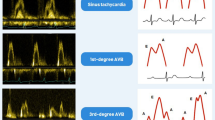Abstract
In patients operated with atrial switch for transposition of the great arteries (TGA), the left ventricle (LV) supports the pulmonary circulation and is thus pressure unloaded. Evaluation of LV function in this setting is of importance, as LV functional abnormalities have been documented and might contribute to development of symptoms. The ventricular contraction pattern in 14 Senning-operated TGA patients and 14 healthy controls was studied using tissue Doppler and magnetic resonance imaging. In the subpulmonary LV free wall, longitudinal strain was greater than circumferential strain (−23.6 ± 3.6% vs. −19.1 ± 3.2%, p = 0.002) as in the normal right ventricle (RV) (−30.7 ± 3.3% vs. −15.8 ± 1.3%, p < 0.001), but opposite to findings in the normal LV (−16.5 ± 1.7% vs. −25.7 ± 3.1%, p < 0.001). Subpulmonary strain and strain rate values were intermediate between those in the normal LV and RV. Ventricular free-wall torsion was reduced in the subpulmonary LV compared with both the normal LV (5.7 ± 3.2° vs. 16.7 ± 5.6°, p < 0.001) and RV (5.7 ± 3.2° vs. 11.4 ± 2.6°, p < 0.05). Furthermore, early diastolic filling of the subpulmonary LV differed from that of the normal LV. The subpulmonary LV displayed predominantly longitudinal shortening, as did its functional counterpart, the normal RV. However, the degree and rate of both longitudinal and circumferential shortening were intermediate between those of the normal LV and RV. This could represent a partial adaptation to the reduced pressure load. Decreased ventricular torsion and diastolic abnormalities might indicate subclinical ventricular dysfunction.


Similar content being viewed by others
References
Derrick GP, Narang I, White PA, et al. (2000) Failure of stroke volume augmentation during exercise and dobutamine stress is unrelated to load-independent indexes of right ventricular performance after the Mustard operation. Circulation 102:III154–III159
Edvardsen T, Gerber BL, Garot J, et al. (2002) Quantitative assessment of intrinsic regional myocardial deformation by Doppler strain rate echocardiography in humans: validation against three-dimensional tagged magnetic resonance imaging. Circulation 106:50–56
Eyskens B, Weidemann F, Kowalski M, et al. (2004) Regional right and left ventricular function after the Senning operation: an ultrasonic study of strain rate and strain. Cardiol Young 14:255–264
Fogel MA, Gupta K, Baxter BC, et al. (1996) Biomechanics of the deconditioned left ventricle. Am J Physiol 271:H1193–H1206
Garot J, Bluemke DA, Osman NF, et al. (2000) Fast determination of regional myocardial strain fields from tagged cardiac images using harmonic phase MRI. Circulation 101:981–988
Haber I, Metaxas DN, Geva T, Axel L (2005) Three-dimensional systolic kinematics of the right ventricle. Am J Physiol Heart Circ Physiol 289:H1826–H1833
Helle-Valle T, Crosby J, Edvardsen T, et al. (2005) New noninvasive method for assessment of left ventricular rotation: speckle tracking echocardiography. Circulation 112:3149–3156
Moon JC, Lorenz CH, Francis JM, Smith GC, Pennell DJ (2002) Breath-hold FLASH and FISP cardiovascular MR imaging: left ventricular volume differences and reproducibility. Radiology 223:789–797
Naito H, Arisawa J, Harada K, et al. (1995) Assessment of right ventricular regional contraction and comparison with the left ventricle in normal humans: a cine magnetic resonance study with presaturation myocardial tagging. Br Heart J 74:186–191
Pettersen E, Helle-Valle T, Edvardsen T, et al. (2007) Contraction pattern of the systemic right ventricle: shift from longitudinal to circumferential shortening and absent global ventricular torsion. J Am Coll Cardiol 49:2450–2456
Reich O, Voriskova M, Ruth C, et al. (1997) Long-term ventricular performance after intra-atrial correction of transposition: left ventricular filling is the major limitation. Heart 78:376–381
Urheim S, Edvardsen T, Torp H, Angelsen B, Smiseth OA (2000) Myocardial strain by Doppler echocardiography. Validation of a new method to quantify regional myocardial function. Circulation 102:1158–1164
Weidemann F, Jamal F, Sutherland GR, et al. (2002) Myocardial function defined by strain rate and strain during alterations in inotropic states and heart rate. Am J Physiol Heart Circ Physiol 283:H792–H799
Acknowledgments
Eirik Pettersen was the recipient of a fellowship from the Norwegian Research Council. We thank Stein Inge Rabben, Ph.D., for providing the Matlab application for analysis of radius of curvature.
Author information
Authors and Affiliations
Corresponding author
Rights and permissions
About this article
Cite this article
Pettersen, E., Lindberg, H., Smith, HJ. et al. Left Ventricular Function in Patients with Transposition of the Great Arteries Operated with Atrial Switch. Pediatr Cardiol 29, 597–603 (2008). https://doi.org/10.1007/s00246-007-9156-1
Received:
Accepted:
Published:
Issue Date:
DOI: https://doi.org/10.1007/s00246-007-9156-1




